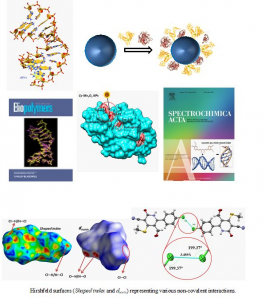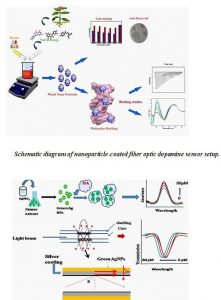Research Guide: Prof C Sudarsanakumar
Research Areas:
Quantum dots for optical power limiting applications: The composition dependent optical nonlinearity and limiting properties of semiconducting metal sulfide nano-particulates are being investigated using Z-scan measurements. Promising candidates are identified in the design of optical devices like optical limiters for protecting human eye and optical sensors at both high and low power laser regimes.
Nanomaterial based fiber optic sensors for bio-applications: Environmental friendly design of Localized Surface Plasmon Resonance (LSPR) based fiber optic biosensors using metal nanoparticles capped with different biomolecules and their application in the detection and quantification of important analytes like dopamine, cysteine, ascorbic acid, ammonia and mercury, which are important in the diagnoses, monitoring, prevention and treatment of several disorders.
Interaction of Natural drugs and its metal-nano- derivatives with DNA: Along with its anti-proliferating studies.: The binding mechanism of DNA with natural drugs as well as their metal-nano- derivatives is being explored using spectroscopic, calorimetric and electrophoresis methods. Computational methods like Docking and Molecular Dynamics Simulation provide further insight at atomic level. MTT assay techniques are used to probe the cytotoxic effects of natural drugs and its derivatives to cancerous and normal human cells.
Interactions studies of Nanoparticles with Proteins: A biophysical approach: When the nanoparticles enter into biological fluids, they interact with the plasma proteins and a “protein corona” will be formed on the nanoparticle surface. The interactions between nano particles and proteins may modulate the mobility and toxicity of nanoparticles and their cell recognition. Therefore, it is necessary to understand the physicochemical interactions of nanoparticles with proteins. The interactions of chalcogenide nanoparticles with proteins are being investigated using spectroscopic and calorimetric techniques.

Structure and Dynamics of Modified Nucleic Acids:Studies on size expanded nucleic acids mainly aim at the exploration of the structural properties of unnatural genetic system.The conformational space of modified DNA and RNA duplex systems (xDNA, yDNA, xRNA and yRNA) were explored through Molecular Dynamics simulation methods to understand the stability of the duplexes and the variation in the structural parameters on account of their modified bases.
Accurate three dimensional structural features of chemical entities using X-ray Crystallography: Our structural chemistry research focuses on the three dimensional molecular structure of highly functionalized organic materials and metal organic complexes to expose the supramolecular interactions. Hirshfeld surface analysis is rapidly gaining popularity and it seeks to comprehend non-covalent interactions to reorganize molecules on the atomic level so as to achieve the goal of producing functionalized derivatives with tuned activity. Cutting-edge quantum chemical tools are being employed to optimize structural and bonding characteristics. Through consultation perspective, our group supports the entire scientific community towards highly challenging structure solution & refinement process up to publication level.

Interaction of Phytochemicals with lectin may reveal new directions to glycobiology: In lectins, apart from the carbohydrate-binding site, other functionally or structurally important sites may also be present which possibly increase the versatility of lectins for future applications. The molecular interaction studies between phytochemicals and lectins through X-ray crystallography could reveal new directions to glycobiology. It might be a logical research strategy towards discovery of novel drug delivery systems.Multifunctional graphene-based SERS approach towards the detection of harmful plastcizers in plastic packaged food & beverages Graphene mediated Surface Enhanced Raman spectroscopy (SERS) substrate with high electromagnetic enhancement is used to detect and evaluate the exposure of harmful chemicals from plastic food packaging. Our aim is to fabricate GSERS based sensors for the detection of Bisphenol A(BPA) and bis(2-ethylhexyl) phthalate (DEHP) in real life samples like drinking water and medicines packaged in plastic entities.
<<< go back